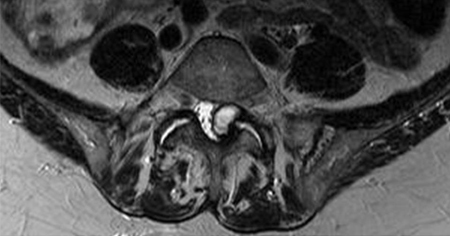Resumen
Definición
Anamnesis y examen
Principales factores de diagnóstico
- dolor lumbar persistente
- dolor de piernas radicular
- síntomas relacionados con la actividad
Otros factores de diagnóstico
- restricción en el movimiento lumbar
- prueba positiva de elevación de la pierna recta
- déficit neurológico (debilidad de las piernas, pérdida sensorial, síntomas en la vejiga y el intestino)
Factores de riesgo
- mayor edad
- influencia genética
- ocupación (cargas axiales excesivas, vibraciones causadas por el transporte)
- tabaquismo
- tropismo de la articulación facetaria y artritis
- morfología pélvica anormal
- cambios en la alineación sagital
- obesidad
- diabetes mellitus
- aterosclerosis
Pruebas diagnósticas
Primeras pruebas diagnósticas para solicitar
- radiografía de la columna lumbar en bipedestación
- imagen de resonancia magnética (IRM) de columna
Pruebas diagnósticas que deben considerarse
- tomografía computarizada (TC) de columna
- radiografías de columna en flexión/extensión
- tomografía computarizada por emisión de fotón único
- mielograma por TC
- discografía
- IRM con gadolinio (contraste)
Pruebas emergentes
- pruebas genéticas
- estudios por imágenes funcionales de la columna
Algoritmo de tratamiento
emergencia neurológica (déficit de la raíz nerviosa o síndrome de la cola de caballo)
dolor de espalda agudo: duración <3 meses desde la presentación inicial o exacerbación del dolor crónico
dolor crónico de espalda: duración ≥3 meses desde la presentación inicial
Colaboradores
Autores
Jwalant S. Mehta, MBBS, MS(Orth), D(Orth), MCh(Orth), FRCS(Orth)
Consultant Spine Surgeon
Royal Orthopaedic Hospital
Birmingham
UK
Divulgaciones
JSM declares that he has received research support from Stryker K2M, Depuy Synthes and Nuvasive; is a speaker for AO Spine and Scoliosis Research Society; serves on the editorial board for the European Spine Journal, the Spine Deformity Journal, and the Bone Joint Journal, is a reviewer for the Global Spinal Journal, and is part of the Paediatric Spine Study Group.
Agradecimientos
Dr Jwalant S. Mehta would like to gratefully acknowledge Dr Giannoulis Kyriakos and Dr Nasir Quiraishi, previous contributors to this topic. GK and NQ declare that they have no competing interests.
Revisores por pares
Jayesh Trivedi, FRCS (Orth)
Consultant Spine Surgeon and Head of Department
Centre for Spinal Studies
Robert Jones and Agnes Hunt Hospital NHS Foundation Trust
Oswestry
Alder Hey University Children's Hospital
Liverpool
UK
Declarações
JT declares that he has no competing interests.
John Ratliff, MD, FAANS, FACS
Associate Professor
Department of Neurosurgery
Stanford University
Stanford
CA
Declarações
JR declares that he has no competing interests.
Créditos aos pareceristas
Os tópicos do BMJ Best Practice são constantemente atualizados, seguindo os desenvolvimentos das evidências e das diretrizes. Os pareceristas aqui listados revisaram o conteúdo pelo menos uma vez durante a história do tópico.
Declarações
As afiliações e declarações dos pareceristas referem--se ao momento da revisão.
Referências
Principais artigos
Kreiner DS, Hwang SW, Easa JE, et al. An evidence-based clinical guideline for the diagnosis and treatment of lumbar disc herniation with radiculopathy. Spine J. 2014 Jan;14(1):180-91. Resumo
National Institute for Health and Care Excellence. Low back pain and sciatica in over 16s: assessment and management. Dec 2020 [internet publication].Texto completo
Expert Panel on Neurological Imaging, Hutchins TA, Peckham M, et al. ACR Appropriateness Criteria® Low Back Pain: 2021 Update. J Am Coll Radiol. 2021 Nov;18(11s):S361-S379.Texto completo Resumo
Artigos de referência
Uma lista completa das fontes referenciadas neste tópico está disponível para os usuários com acesso total ao BMJ Best Practice.

Diagnósticos diferenciais
- Tumor vertebral
- Infección cervical
- Dolor de espalda postural
Mais Diagnósticos diferenciaisDiretrizes
- CDC prescribing opioids for pain
- ACR appropriateness criteria: low back pain
Mais DiretrizesFolhetos informativos para os pacientes
Deslizamiento de disco (zona lumbar): ¿qué es?
Deslizamiento de disco (zona lumbar): preguntas para formularle al médico
Mais Folhetos informativos para os pacientesConectar-se ou assinar para acessar todo o BMJ Best Practice
O uso deste conteúdo está sujeito ao nosso aviso legal
